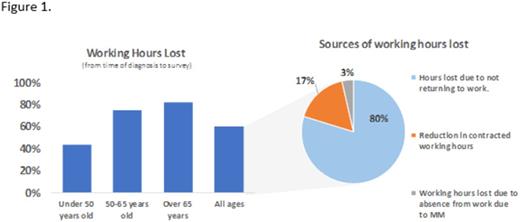Abstract
INTRODUCTION
Autologous stem cell transplant (ASCT) is the standard of care for patients with newly diagnosed multiple myeloma (MM) who are typically < 65 years of age. Many are employed at the time of diagnosis and may be hoping to continue working after ASCT. Capacity to work can therefore be an important consideration for patients as well as for employers and wider society. This study sought to investigate productivity and patient motivation to return to work following ASCT.
METHODS
An online, cross-sectional survey was conducted to collect data on paid work history before and after ASCT. Productivity was defined as paid working hours, and information on number of hours worked, current work status, and work impairment was collected using the Work Productivity and Activity Impairment (WPAI) Questionnaire. Further questions inquired about patient experiences, decision-making, and motivations. Eligible patients with MM were ≥ 18 years old, resided in the EU5, and had undergone ASCT. Patients were recruited via patient associations or social media. Data were analysed to determine rates of returning to work, working hours lost between the time of diagnosis and the time of the survey, and current work impairment.
RESULTS
A total of 115 eligible patients registered and completed the survey. Average age of patients at the time of survey was 57 years, with 27% < 50 years, 50% 50-65 years, and 23% > 65 years. The male:female ratio was 46:54. The mean time since ASCT to time of survey was 41.5 months.
The majority of survey patients (83% [n = 95]) considered being personally productive important to them. At the time of diagnosis, 77% of respondents (n = 88) were employed and of these, 52% (n = 46) had wished to return to work following ASCT. Only 9% (n = 8) reported not wanting to return to work, while 55% rated the personal goal of returning to work as important.
Following ASCT, 51% (n = 45) returned to and remained working at the time of completing the survey. The percentage of total working hours lost, between diagnosis and time of survey, was 60%. The causes of these productive working hour losses were individuals not returning to work (80%), reduced working hours (17%), and absenteeism (3%).Those > 50 years old contributed a greater proportion of those losses (Figure 1). For those who returned to work, total losses amounted to 23% of their working hours at the time of diagnosis. Productivity losses were driven by 2 groups, a group that did not continue to work (n = 43) contributing 80% and a group who continued to work (n = 45) contributing 20% of the overall losses. Mean overall work impairment in those currently working was 32% and absenteeism was 7%, according to the WPAI instrument.
There were changes for working patients, with 57% (n = 50) changing their employment status, including 32% (n = 28) who retired. Of those who retired, 79% (n = 22) described the transition to retirement as arising from the diagnosis of MM or ASCT. The greatest change in employment status was seen in the 50-65-years group (n = 44), in which 29 changed work categories, 22 retired, 3 changed to part-time, and 4 were on sick leave.
"Returning to normality" was the most frequently stated reason (n = 13 [41%]) for returning to work, followed by "financial reasons" (n = 7 [22%]), while others (n = 9 [28%]) gave "multiple reasons." The reasons for not returning to work were mainly related to health-related factors associated with MM or ASCT: "lacking strength or fitness for job" (n = 11 [41%]), "effects of MM or treatment" (n = 5 [18%]), with some stating a "change in priorities" (n = 5 [18%]).
CONCLUSION
There are considerable changes for working patients following ASCT, with only half of the respondents returning and continuing in employment. There was a notable loss in working hours driven by those not returning to work, and to a lesser extent, by reduced hours and work impairment for those continuing in work. For the working group, losses were lower and for them remaining in work was important. The change in work status was undesired for most patients. Further studies of patient productivity post-ASCT are warranted to confirm these findings and to understand patient and caregiver needs.
Jackson: Celgene: Honoraria; Chugai: Honoraria; Takeda: Honoraria; Amgen: Honoraria; J&J: Honoraria. Alderson: Celgene: Consultancy. D'Souza: Celgene: Consultancy. Davies: Have provided consulting services to Celgene as a consultant to, and formerly an employee of ICON Plc. Involvement in this study is funded by Cogentia.: Consultancy, Employment. Dhanasiri: Celgene Corporation: Employment, Equity Ownership. Sculpher: Celgene via Cogentia: Consultancy.
Author notes
Asterisk with author names denotes non-ASH members.


